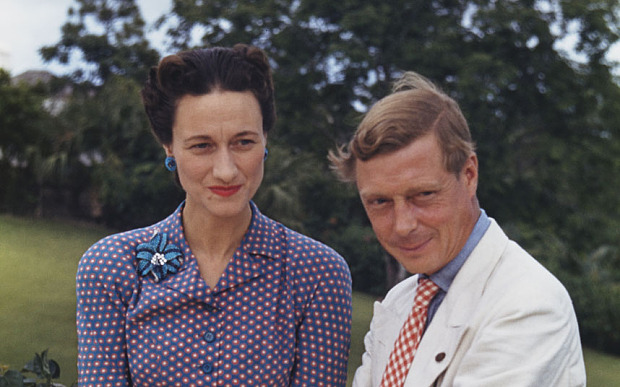Bulletin #82 - Apr 2015
17 Carnations by Andrew Morton

April 3, 2015
Reviewed for The Churchill Centre by ANNE SEBBA
 Surely, not another book about the abdication, I hear you groan? Is there really anything more to say about the Windsors and the one-sided love story that offered a solution to this crisis?
Surely, not another book about the abdication, I hear you groan? Is there really anything more to say about the Windsors and the one-sided love story that offered a solution to this crisis?
And here I must declare an interest. Having recently written a book about Wallis Simpson myself, I have lost count of the number of times I have been asked that same question. Equally, I am aware of the perennial fascination with the story of the handsome king who gave up his throne to marry a twice-divorced American of no particular beauty. How to explain it? So I was eager to read this new book by Andrew Morton, the journalist who wrote about Diana, Princess of Wales—Her True Story in Her Own Words—changing forever the way the world perceived her relationship to the Prince of Wales as well as the way the world now looks at the royal family. Could he pull off the same trick again with an earlier Prince of Wales?
Morton’s new book, 17 Carnations: the Windsors, the Nazis and the Cover Up, begins with a longish section retelling the story of the young Prince’s early life, his racy dress sense, his heavy drinking and smoking and above all his improper dalliances and threats of suicide. Then there is the familiar tale of his first serious love affair, that with Freda Dudley Ward where Morton observes Winston Churchill responding to the prince “like a surrogate son” and Churchill’s comment that, “It is quite pathetic to see the Prince and Freda. His love is so obvious and undisguisable.” Then we learn about the arrival of Wallis and Ernest Simpson in London and how they got to meet the Prince. Soon Morton is leaping from Chips Channon’s gossipy diary, discussing Emerald Cunard “who is rather eprise [in love with] Herr Ribbentrop (the German Ambassador) through Mrs Simpson,” to a statement that Ribbentrop sent seventeen carnations every day to her London apartment. (Or was it—Morton acknowledges—as some say, roses?) Although nobody can prove either. The number apparently signified one for each day they had slept together hence, just a few pages later, when the newly abdicated Duke and Duchess are in Germany meeting Hitler at Berchtesgaden, Ribbentrop is described by Morton as Wallis’s erstwhile lover.
Once war was underway and Churchill Prime Minister, the Windsors’ undoubted pro-German, defeatist attitude was clearly unacceptable. By July 1940 there was a major change in the relationship between the Duke and Churchill with the latter warning the Duke that any refusal not to go where he was sent or to obey military orders would not be tolerated. The Duke, realising that he could no longer rely on Churchill to be his unquestioning ally, eventually left Lisbon for the Bahamas, where the couple spent the remainder of the War with the Duke as Governor but not before Wallis requested diplomats in Lisbon and Nice to organise the return of a favourite green bathing costume which she had left behind in the south of France. From then on, as Lord Moran recorded, Churchill began to dread every time there was a communication with the exiled duke.

2025 International Churchill Conference
The final and most interesting section of the book is concerned with the discovery in 1945 of a file detailing the events of 1940 from the moment when the Duke and Duchess fled their home in France and made their way through neutral Spain to Portugal. German diplomats were constantly sending back to Berlin tales of the couple’s treasonous talk, particularly the Duke’s belief that Britain could not win the War and should therefore make peace as quickly as possible. The Germans in turn considered kidnapping the Duke and keeping him in Spain as a useful negotiating tool.
Details of the Lisbon episode and the Windsors’ bad behaviour were considered so potentially damaging to the wider royal family as well as to the Duke himself that Churchill and Clement Attlee, by then prime minister, attempted to have “the Windsor File” suppressed, exempted from plans to publish other material from the German archives.
Morton is no academic historian; there are too many anecdotes that rely on secondary, often rather dubious, sources, too many rumours repeated and “whispers in society circles, willing to believe anything.” One author, quoted by Morton for his account of the wartime activities of the Duke, used a number of documents held at the National Archives in Kew that were subsequently discovered to be forgeries. Morton recounts how, following George V’s death in January 1936, Hitler watched a Pathé newsreel of the new king, Edward VIII and comments, novelistically, that Hitler “may have acknowledged to himself that she seemed to be able to hypnotise men in the way that he could transfix audiences with his mesmerizing rhetoric and penetrating gaze.”
The stories in 17 Carnations may all have been aired elsewhere but Morton writes with journalistic pace, and, by bringing them all together for a twenty-first century readership not familiar with details of the scandals, it becomes clear why Churchill, the Duke’s loyal friend in 1936, was still concerned in the 1950’s to protect the institution of monarchy he so revered as well as the foolish Duke himself. By the time the documents were published, in 1957 under a misleadingly boring title, Edward and Wallis were marginal figures, leading a superficial café-society life and no threat to the existing royal family.
What does make this book a useful addition to the extensive Windsor literature are the photographs: there are some informal ones of Wallis and Edward before they were married as well as some new ones of the couple in Germany in 1937 meeting Hitler and other Nazis. These are interesting even though the trip was undertaken mostly to make Wallis feel she was being treated with Queen-like respect, and it is arguable whether or not they show the Duke’s interest in what he believed Hitler was achieving in Germany.
Anne Sebba is writing Les Parisiennes: how women lived, loved and died in Paris from 1939–49 due to be published by Orion in 2016.
Subscribe
WANT MORE?
Get the Churchill Bulletin delivered to your inbox once a month.






